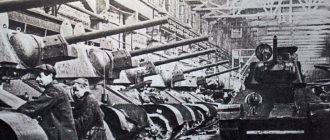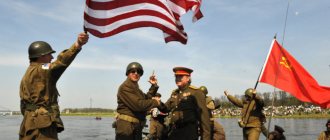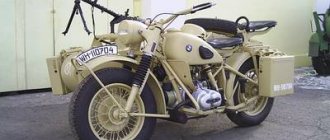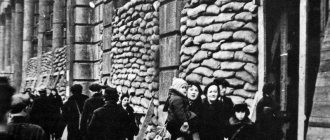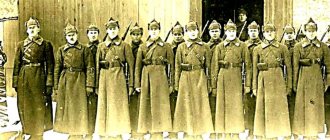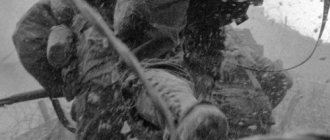Supplying the front with food was a less noticeable, but important confrontation during the Great Patriotic War. After all, no matter how good the guns, tanks and planes are, hungry personnel will not be able to handle the battle. This means that food can be considered as a full-fledged weapon. “An army marches on its belly,” said Prussian King Frederick II in the 18th century.
- Due to rank
- “On the offensive - on an empty stomach”
- "Thinner" country
- "Non-Soviet attitude"
- Eat and survive
- Front-line “pampering”
- Hunger blindness
- German quality
The norms for issuing provisions to military units were strictly regulated in the Red Army and did not change throughout the war. However, the actual situation with the supply of food greatly depended on the tasks of the army, the nature of the battles, the terrain and the season. One way or another, the soldiers on the front line ate better than the employees and civilians in the rear.
In general, both in terms of the composition of the “food basket” and in terms of difficulties in providing food, the USSR and Germany had parity. Perhaps the key advantage for our country was provided by the unpretentiousness and amazing ingenuity of the Soviet soldier.
Due to rank
Soldiers' canteen in the Tiraspol region.
Olga Lander / RIA Novosti
At the time of the German attack, the Red Army had a peacetime “menu” in effect, which became untenable in the conditions of field catering. The result of its processing was the Decree of the State Defense Committee (GKO) of the USSR No. 662 of September 12. Until the end of the war, it determined the now legendary “quotas” for each product.
The main thing was bread made from rye flour, which replaced pre-war wheat: 800 g daily in the warm months, 900 g in the cold months. In addition, each soldier was entitled to half a kilo of potatoes, 320 g of other vegetables, 170 g of cereals and pasta, 150 g of meat, 100 g of fish, 50 g of fat and 35 g of sugar. In some branches of the army they were fed more generously. The pilots were given more cereals (190 g), vegetables (385 g), meat and poultry (390 g) and sugar (80 g). The Air Force ration also contained products whose taste the infantry had completely forgotten: milk (200 g fresh, 20 g condensed), cottage cheese (20 g), sour cream (10 g), egg (0.5 pcs.), cheese (20 g ) and dried fruits. Also, on airplanes, in tanks and in reconnaissance companies, nutritional reserves were provided in case of accidents or ending up in unfamiliar terrain: condensed milk, canned food, sugar, chocolate, cookies.
The naval menu had its own nuances. Submariners regularly ate sauerkraut, pickles and raw onions - these products compensate for oxygen deficiency. On large ships there was “homemade” bread baked right on board.
The allowance of the officers also differed: in addition to the standard amount of food, they were entitled to 40 g of butter or lard, 20 g of cookies and 50 g of canned fish per day. The higher authorities did not limit themselves to this: evidence has been preserved of how balyks, sausages, and wine were brought to the generals’ headquarters. As for middle ranks, in practice the difference in nutrition did not always manifest itself: a lieutenant could eat from the same pot with soldiers, especially on the front line and towards the end of the war.
In the rear, with the beginning of the war, on the contrary, food began to worsen. Compared to front-line soldiers, soldiers from non-combatant and reserve units received less than 150 g of bread, 50 g of cereals and pasta, 75 g of meat, 10 g of sugar and fats. The maintenance of guard units and cadets was reduced. The latter responded to complaints with Suvorov’s phrase “It’s hard in training - easy in battle.” As a result, young men were eager to go to the front, seeing in it a release from the half-starved everyday life of school.
At the same time, the State Defense Committee demanded that dietary standards be maintained throughout the Red Army. It was believed that a man of military age needed 2600–4000 kcal per day. Therefore, even in guard units, the energy value of the diet was 2659 kcal. Employees of combat units were allocated 2822 kcal, combat units - 3450 kcal, air force - 4712 kcal.
But this is according to the documents. In reality, the food situation was far from rosy.
Industrial mobilization
No less effort was required to quickly restructure the food industry. This was task number one, because soldiers could not go into battle hungry , and soldiers’ rations and field kitchens required already processed agricultural products - crackers, stewed meat, packaged cereals and food concentrates, etc.
In record time, it was necessary to increase the production of food products at the remaining enterprises, using all reserves within production.
In the shortest possible time, the production of a special assortment of crackers, food concentrates, vitamins, dry alcohol, glycerin and other products was organized, which were supplied to hospitals and military units.
For example, Moscow Bakery No. 11 switched to producing noodles, Voinskiye crackers, and Dorozhnye gingerbread.
At the Red October factory, already in August 1941, the caramel workshop was converted to produce food to supply the front, and in October, the part of the confectionery equipment that was relocated from Moscow to Samara began producing chocolate for the front. In conditions of fuel shortage, we mastered the production of caramel and sweets using a semi-cold method.
The Moscow distillery produced not only “front-line hundred grams”, but also a combat weapon for protecting infantry from enemy tanks. It was here that bottles with a flammable gelatinous mixture were produced, which the fascist troops called the “Molotov cocktail.”
An ammunition shop was also created at the factory named after. Babaeva. It produced flame arresters and phlegmatizers for artillery and tank guns, and fuses for grenades.
But first of all, the factory provided for other front-line needs. In a short time we mastered completely new technologies. Already in September 1941, a food concentrates workshop - millet, buckwheat, and rice porridge were produced in briquettes. Up to 30 tons of concentrates were produced daily, from which food could be quickly prepared in the field.
And in order to provide the population with food proteins, they launched a yeast workshop. Gradually, the production of sweets with alcohol was established for the active army, and for the population - sweet water with saccharin.
At food enterprises, workers essentially moved to a barracks position and fulfilled two or three production standards, competing for the title of front-line and guards brigades.
“On the offensive - on an empty stomach”
It was still necessary to prepare food from the food “raw materials” supplied to the front. For this purpose, each unit had a field kitchen - a special trailer with boilers and a chimney. Hot meals were provided in the morning before dawn and in the evening after sunset: the soldiers lived during daylight hours on bread and canned food.
The dishes were prepared simply, often the cook randomly mixed meat, cereals, vegetables in the cauldron - everything that was at hand. The result could be kulesh (liquid porridge with meat) or “vegetable confusion” (from the memoirs of culinary historian William Pokhlebkin). “Soup soup and porridge are our food,” the soldiers repeated, accurately describing everyday life at the front.
However, “lunch on schedule” was not at all guaranteed. It took about half an hour to light the field kitchen with firewood, and almost three hours to prepare a two-course dinner for a company of soldiers. Moreover, the kitchen was installed at a distance from the line of fire, so it also took time to “transport” thermoses of food into the trenches.
Long battles disrupted the daily routine, and with the rapid advance of troops, kitchens and convoys could not keep up. It was forbidden to cook food on the march, and at night, when the advance stopped, commanders usually forbade lighting fire, so as not to give themselves away to the enemy. “There is a law of war that is not new:/In a retreat, you eat to your heart’s content,/In defense, this way or that,/In an offensive, you eat on an empty stomach,” noted Alexander Tvardovsky in the poem “Vasily Terkin.”
In general, serving as a regimental cook required great dedication. Like orderlies and signalmen, “cooks” were responsible for the fate of dozens of colleagues. And if the kitchen could not get through “to its own” due to shelling or impenetrable forests, the threat of starvation hung over the soldiers. There is a known case in September 1943, when the vanguard of the 155th Infantry Division crossed the Dnieper, and the kitchen was “stuck” on the opposite bank, and they had to transport hot food by boat under enemy fire.
It is not surprising that the cooks were prominent people in the regiment: the soldiers tried to get a job in the kitchen, help them, and establish good relationships. “Away from the authorities, closer to the kitchen,” the hero of the film “Only “old men” go into battle” formulated the soldier’s wisdom. The field kitchen acted as a kind of “cabin unit”, because during lunch you can at least briefly escape from the horrors of war. Perhaps this explains the nostalgic and heartfelt attitude towards these “pot-bellied” devices with a stove, boilers and a chimney.
Made some porridge
Lieutenant Colonel Anton Turchanovich proposed his own option. The 1904 patent document called it a "universal portable hearth." It was transported on a cart or pulled from the sides using poles by four people. This kitchen became the prototype of the KP-42 model that has come down to us, which was used during the war. What was she like:
Photo: © RIA Novosti
At the front, soldiers received hot meals twice a day - before dawn and after sunset. During the day, only bread was given out. After eating, the fighters had no food left. This made transitions easier and protected from poisoning.
76.8 million people were on state food supplies in 1941 - 1945. Mostly military personnel.
Meadow bowler
20 million tinned pots were produced by plant No. 700 of the People's Commissariat of Ferrous Metallurgy in Lysva (now Perm Territory) during the war years. The same company produced ammunition casings and steel soldiers' helmets.
"Thinner" country
“Narkomov’s 100 grams” were not intended for “bravery.” They were given to a soldier after a battle as encouragement, a way to relieve stress, keep warm and remember the dead.
Alexander Kapustyansky / RIA Novosti
Sometimes GKO standards were not met due to a simple lack of resources. After all, a country’s ability to produce material goods directly depends on the state of the “real sector” of the economy. In this sense, the readiness for war turned out to be low. Due to the rapid retreat in the western regions, more than 70% of food supplies were lost (Nikolai Voznesensky, “The Military Economy of the USSR during the Patriotic War”). By 1942, the German occupation left behind the front line over 50% of the cultivated areas, oil mills and canneries.
Added to this was the mobilization of agricultural machinery and the male half of the peasantry to the front. As a result, the grain harvest in 1942 fell compared to 1940 by 70% (from 96 million to 30 million tons), potatoes - by 69% (from 76 million to 24 million tons), sugar beets - by 88% (from 18 million to 2 million tons). By the end of the war, rates had recovered to 50–60% of pre-war levels.
The most difficult conditions arose on the Leningrad Front, where in the winter of 1942 the soldier’s ration was cut in half: at the front line they received 500 g of bread and 125 g of meat per day, in the rear units - 300 g and 50 g. Only in the spring was the supply of food along the Road of Life through Lake Ladoga made it possible to create weekly reserves and establish the actual implementation of standards.
But even in the most difficult months, army units had a better lot than other citizens of the USSR. Due to the introduction of the rationing system in July 1941, the People's Commissariat of the Food Industry distributed food in such a way that the best of what was available was sent to the front. The soldiers knew firsthand about the impoverished existence in the rear from letters from relatives. Today it is believed that a total of about 4 million Soviet citizens died from hunger, infections and diseases.
Fed German children
“Goebbels suggested that the Soviets would destroy the German nation, but the first thing they did was feed it,” wrote German historian Peter Jahn. From 1996 to 2005, he was director of the German-Russian Museum Berlin-Karlshorst and wrote a book about General Nikolai Berzarin, the first post-war commandant of Berlin. Nikolai Erastovich introduced food cards for the city population, which prevented the emergence of a black market. Immediately after his appointment on April 24, 1945, he organized the clearing of rubble at the airport so that planes from the USSR could land there with humanitarian aid. All children under eight years of age received additional milk.
31 thousand food service workers were awarded orders and medals of the USSR. 52 people became Heroes of the Soviet Union, 30 became Heroes of Socialist Labor.
Nina Alekseeva
#19/2021 WWII Victory Day
"Non-Soviet attitude"
Another reason why the Soviet soldier was malnourished was the abuses of the quartermasters. On the way from warehouses to combat positions, the products passed through many intermediaries, and some were inexplicably “lost.”
The soldiers saw this, but were powerless to change anything. From the book “Memories of War” by art critic Nikolai Nikulin: “They stole without shame and conscience, whoever could. The soldier had to keep quiet and endure.”
“We are fed poorly, three times a day with water and buckwheat, thin soup... I feel a loss of strength,” wrote the deputy commander of the mortar company of the reserve rifle regiment A.P. Popovichenko to the wife.
The wording from the reports on the inspection of field kitchens is even harsher. In the summer of 1942 on the North Caucasus Front: “The food is prepared monotonously, mainly from food concentrates.” At the same time, on the Southern Front, soldiers complained “about the liquid and monotonous food delivered to them in a cold state,” and instead of tea they drank “raw water with sugar.”
At the end of 1942, inspectors were not satisfied with a raid on the 8th Guards Rifle Division: the kitchens were “in an unsanitary condition”, the soldiers “systematically do not receive enough” food due to the “negligence and lack of control” of the authorities. Direct facts of corruption were vaguely called “a non-Soviet attitude to the preservation and consumption of food.”
The perpetrators were demoted and denied promotion to new ranks, but the abuses continued until the end of the war. Therefore, soldiers welcomed cases when, due to the impossibility of organizing hot food, they were given dry rations at a “fixed rate.” It included crackers, canned food, sausage, dry fish and even tea leaves.
Sukhpay opened up wide scope for barter transactions: soup for compote, roach for potatoes, bread for sugar, tea for tobacco. Even the soldiers’ personal belongings and ammunition were involved in the in-kind exchange. Formally, “barter” was prohibited, but it was impossible to eradicate it.
Losses during the occupation
Before the war, the USSR managed to modernize the food industry, equipping enterprises with modern equipment and increasing production volumes.
But by the end of 1941, more than half of the enterprises of the People's Commissariat of the Food Industry of the USSR, primarily the sugar, butter, canning and tobacco industries, were in the occupied territory.
That is, those that produced products that were primarily needed to supply the army.
For example, out of 210 sugar factories in the country, 196 were completely or partially destroyed and sugar production in 1942 decreased by 29 times compared to the pre-war volume.
In total, the fascist invaders destroyed 4,490 meat and sausage, cheese, dairy and butter factories, 649 distilleries, 47 canning and 29 oil and fat factories, and 157 bakeries.
Hitler's troops captured that part of the country that contained 47% of the cultivated area and produced 30% of all industrial products, including food products. That is, the agricultural base and the capacity of the food industry have declined catastrophically. The invaders ruined collective farms, and during the war years 17 million heads of cattle and 20 million pigs were taken from the population of the occupied territories of the USSR.
According to expert estimates, the total damage to the USSR from the destruction of food production, crops and livestock amounted to 257 billion rubles.
“Capital of the Country” has already written about the heroic efforts that were used to restore agriculture during the war.
Eat and survive
Accumulating supplies, Soviet soldiers moved on to independently solving the food problem. It was considered normal that, in parallel with the work of the field kitchen, the personnel were divided into groups around their own fires. Here culinary improvisations began: everyone at the front knew how to cook, as well as trim themselves, but those who were especially talented at “conjuring” the boiler were popular among their colleagues. Prepared food was divided by eye - what kind of standards are there?
The brutality of the war inspired boundless Russian ingenuity. It is from there, from the harsh everyday life at the front, that the famous soldier’s tricks come from. On a long march, put a cracker on your cheek. Before a fight, leaving your stomach empty will give you a better chance of surviving an abdominal wound. In the cold, warm a piece of bread under your overcoat. It is mandatory to carry a spoon behind the top of the boot, and even scratch personal information on it so that the body can be identified. And so on.
During supply interruptions, the Soviet warrior managed to survive on “grazing.” As soon as the ice melted in the spring, we fished in nearby reservoirs. In the summer they extracted berries and wild honey (sometimes doing this at the same time as the Germans - at these moments an impromptu truce was established). In the fall, they collected potatoes from the gardens. In especially difficult periods, ears of corn, linden buds, acorns, chestnuts, groundnuts, quinoa, wild garlic, and nettles were used. They sent regimental horses to slaughter if they had nothing to feed them themselves.
An extreme option is described by Leonid Rabichev (the book “War will write off everything. Memoirs of a signal officer of the 31st Army. 1941–1945”): at the end of the winter of 1943, frozen horses killed the previous fall were dug out from under the snow in his unit. “At first they cut off the top layer of meat covered with worms, then they stopped paying attention to it. There was no salt. They cooked the horse meat for a very long time, the meat was tough, rotten and sweetish, apparently disgusting, but then it seemed wonderful.”
A great help for the Red Army soldiers was food according to the “grandmother’s certificate” - the help of the local population. In literature and films about the war, the stationing of troops in the countryside has become a popular plot: there is both the motif of the hearth and the unity of the army with the people. It was not customary to refuse soldiers; they were often given their last. From the memoirs of infantry officer A.Z. Lebedintsev, who spent the night with a peasant family: “I left them money, but they didn’t take it, hoping that maybe some kind housewife would feed their sons.”
True, during periods of retreat, the soldier could face the indignation of residents, concerned that they were being left to the mercy of the Nazis. “Who will fight for you?” – a village woman asked Vasily Shukshin’s hero in the film “They Fought for the Motherland.” And yet they did not directly refuse the boarding house - in extreme cases, they withheld food. Then the soldier had to get them by cunning - almost like in the fairy tale “Porridge from an Axe.”
To be fair, the “cooperation” between the army and the population was two-way: the soldiers helped restore destroyed houses, and the field kitchen fed homeless children and lonely old people they met along the way.
Another source of provisions for the soldier was “edible trophies.” They could have been acquired by accident - for example, when a Luftwaffe plane mistakenly dropped rations into a Soviet trench (however, our “corn workers” had the same “misses”), or as a result of a planned capture of enemy vans.
At the same time, the reaction to a foreign product could be different - from delight to culture shock. For example, Soviet soldiers spoke with respect of German sausages, chocolate and concentrated soups, but had difficulty accepting fruit spreads (“some kind of hybrid of ersatz honey with butter”).
The same applied to the food aid that the USSR received from the USA. American sausages in cans were in great demand, but corn grits remained misunderstood. Cooks tried to add it to bread, but it became brittle and quickly stale.
Front-line “pampering”
Amazing myths have developed around the alcohol rations of troops. First of all, this is not an invention of the Soviet command. The Russian soldier was treated to alcohol from the very foundation of the regular army: Peter the Great’s regulations of 1716 introduced copious “wine portions.” Secondly, the daily “People’s Commissar 100 grams” were not intended for “bravery.” They were given to the soldier after the battle as encouragement, a way to relieve stress and remember the fallen fellow soldiers.
Thirdly, this lasted only a few months. The distribution of vodka to soldiers started on September 1, 1941, and from May 15, 1942, the “reward” nature of the strong drink was emphasized: the norm was increased to 200 g, but from now on it was poured only to those who distinguished themselves in battle. A year later, vodka was removed from all units except those that participated in the offensive.
A separate question is how the distribution of alcoholic “fuel” actually took place. Pure alcohol was brought to the front line, and local commanders diluted it, bringing it to the desired consistency. As a result, judging by the memoirs, the result was a “cloudy liquid of a light coffee color,” which was dosed by eye: from the regimental can into the platoon bowler, individual portions were measured in the cap of a 76-mm charge. No one knew exactly how many grams and degrees the soldier received after a complex chain of operations. If there seemed to be few of them, there was only one way out: use the industrial alcohol and antifreeze present in the units, filtering the liquid in a gas mask.
Much more stable in this sense were the supplies of tobacco products: 20 g of shag per day plus 7 smoking books for rolling papers and 3 boxes of matches monthly. This norm remained unchanged. True, heavy smokers (and many became such at the front, because smoking dulls the feeling of hunger) absolutely did not have enough of it. The most resourceful people collected rotted horse manure and used it instead of tobacco.
It is curious that the command encouraged the soldiers to give up bad habits. In 1942–1943, non-smokers began to be given 200 g of chocolate or 300 g of sweets per month instead of tobacco. And in the navy, teetotalers received 10 rubles in monetary compensation instead of a daily portion of wine.
In a new place
In the Volga region, the Southern Urals, Siberia, Kazakhstan, Central Asia and Transcaucasia, the construction of food enterprises began on the basis of equipment taken from territories occupied by Nazi troops.
For example, valuable equipment and specialists from the Babayev factory were evacuated from Moscow to Alma-Ata, and at the beginning of 1942 they launched a new confectionery shop that produced 20 thousand tons of products per year.
In total, during the war years, over 150 food industry enterprises were put into operation in the USSR, including 13 sugar factories, 12 canning factories, 26 alcohol factories, 12 bakeries, 16 oil and fat factories.
This made it possible to significantly increase the production of special products for the army. Thus, by the end of 1941, the production of food concentrates increased by more than half compared to the beginning of the same year.
Mass production of food concentrates was created in Gorky, Syzran, Kuibyshev, and increased through the construction and re-equipment of workshops in Serpukhov, Moscow, Ivanovo, Engels, Semipalatinsk, Orsk, Irkutsk and Transcaucasia.
In total, during the war years, the industry produced 506 thousand tons of all types of food concentrates - cereal soups, borscht, various porridges and vegetable mixtures.
Starting from the second half of 1943, the restoration of the food industry and agriculture in the liberated territories began. For example, by the end of 1943, sugar factories in the Kursk region and Ukraine, restored with the help of the troops of the Ukrainian fronts, began to operate and supply sugar to the front.
In addition to products for soldiers' rations, it was necessary to quickly organize the production of equipment for field kitchens, much of which was lost in the first months of the retreat.
In the fall of 1941, things reached the point that the combat formations of the Western Front were only 30–40 percent provided with field kitchens.
In this situation, the production of hearth kitchens at enterprises in Serpukhov, Maloyaroslavets, Podolsk and other cities near Moscow. And later the equipment began to be produced in the rear.
Hunger blindness
Was there famine in the Red Army? In Soviet times, such issues were little studied. In addition, front-line soldiers usually reported in their letters home that the supply to the front was in order. But here there was also a desire to reassure loved ones, and the habit of not losing heart in any situation, and the idea of demanding nutrition as a “shameful” pettiness: eat something and be satisfied.
Nevertheless, exhaustion haunted the soldier throughout the war. Moreover, we are talking about both starvation (there are no statistics on this matter, we only know that there were such cases: for example, in November 1942, 25 people died in the 279th Infantry Division due to malnutrition), and about the diagnosis of dystrophy ", with which the soldier ended up in the hospital - it could take years to eliminate the consequences of the disease.
“We are not even hungry - a person is hungry who clearly realizes that he wants to eat, in which this desire is isolated from him; In our country, hunger has become a constant part of thoughts, feelings, sensations; it has ceased to be clearly felt, having merged entirely with us,” wrote philologist Leonid Andreev in his memoirs. There is widespread evidence of how war veterans did not like to remember the hardships of those years, but treated every piece of food with extreme care, always collecting crumbs from the table.
But sufficient food did not guarantee the soldiers the absence of health problems. Thus, in the spring of 1942, the confusion with food at the beginning of the war made itself felt: they did not make supplies in time - by the end of winter there were virtually no vegetables left in the country. As a result, due to a lack of vitamin C, an epidemic of scurvy began among the troops. Soldiers’ teeth fell out, front-line writer Daniil Granin said: “We put them back in with our fingers. You can’t chew with your gums! The battalion spent whole days sucking pine anti-scorbutic briquettes, this helped a little.”
Another consequence of vitamin deficiency was loss of vision in low light - night blindness, which sometimes led to terrible pictures. “One soldier led a line of others. He felt the way with a large stick, and the rest walked in single file, holding tightly to each other. They didn’t see anything” (Nikulin).
Soldiers regularly suffered from diseases of the digestive system. This is not surprising, because after a long existence from hand to mouth, fate sometimes provided them with a chance to eat to their heart's content. Out of happiness, the soldier began to eat “in reserve,” sometimes consuming more than his daily ration in one sitting. “Completely hungry, we ate without discerning or thinking about the consequences - we knew that tomorrow the painful sensation would come again” (Andreev).
But the closer the Victory was, the less criticism there was about the organization of food at the front. There are several reasons for this. Firstly, the Soviet economy managed to rebuild: the acreage in the Volga region, Kazakhstan and the Southern Urals was expanded, and new food enterprises were opened. In particular, they copied German know-how - con.
Secondly, the army has learned to feed itself. The reserve units began to stock up on bread and vegetables for those on the front lines, cultivating large areas. Thus, the Bryansk Front at the end of 1942 covered 100% of its own needs for grain and vegetable crops. Thirdly, Soviet troops recaptured Ukraine, which immediately improved food and vegetable supplies. And then they moved to Europe, where they feasted on German meat, Czech beer, and Austrian desserts.
Vitamin bomb
Food supplies to the front, especially at the beginning of the war, were not always regular. Yuri Vladimirovich Nikulin recalled how in 1941 the soldiers of their battery, stationed on the shores of the Gulf of Finland, lost their sight from hunger and vitamin deficiency:
Yury Nikulin. Photo: from personal archive
- All the blind people are next to huge guns. For each calculation - and this is eight - ten people, no less - they gave one sighted person. And the sighted man led the blind to their positions. Like in a painting by Bruegel. The sighted one aimed the gun, and the others dragged the shells, loaded them by touch...
In order to avoid vitamin deficiency, soldiers sucked pine anti-scorbutic briquettes. As for vegetables, the situation was as follows:
- fresh or pickled cabbage 170 g
- carrots 45 g
- beets 40 g
- onions 30 g
- roots, greens, cucumbers 35 g
